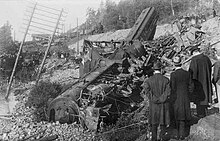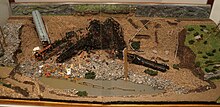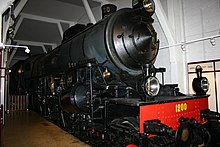Getå railway accident
The Getå railway accident occurred on October 1, 1918 near the small town of Getå in the Swedish municipality of Norrköping . At least 42 people died. It was the worst railway accident in Sweden's history.
Starting position
route
The Järna – Åby railway from Åby to Norrköping was inaugurated on October 1, 1913. A geological survey of the site was carried out even before construction , as a fault was known in the later accident area . Here the route ran along a steep slope made of layers of clay and gravel , which leads down to the shores of Bråviken Bay .
The spring of 1918 had been so dry that cracks had formed in the ground. In contrast, September was unusually rainy, so that the water seeped into the crevices and soaked the ground with water. Soaked with water, the soil also became heavier. A train passed the accident site at 18:26 without any problems. At 6:50 p.m., a brewery car had driven into the scene of the accident on the country road without noticing anything.
train
The passenger train No. 422 consisted of a locomotive and ten cars , the passenger cars with a wooden structure:
- Steam locomotive F 1200 (preserved in the Swedish Railway Museum in Gävle )
- Post car DFo 1107 ( destroyed in the accident )
- Freight wagon F1 25591 (destroyed in the accident)
- Passenger car C3d 2050 (destroyed in the accident)
- Passenger car Co5 2039 (destroyed in the accident)
- Passenger car Co1 1235 (destroyed in the accident)
- Passenger car Co5 2044 (destroyed in the accident)
- Dining car ABo3 2466 (repaired after the accident, scrapped 1960)
- Sleeping car Bo1 1015 (undamaged, scrapped 1949)
- Passenger car BCo 1429 (undamaged, scrapped 1963)
- Extra freight car G3 19003 (undamaged, scrapped 1952)
The train left Malmo at 7 a.m. A locomotive change took place in Mjölby : The F 1200 replaced the F 1271 locomotive. In Norrköping the train was 12 minutes late, until Åby it had caught up two minutes. About 170 people were on the train.
the accident
The dispatcher in Getå had the first inkling of an impending disaster when he registered fluctuations in the telephone lines between 6:33 and 6:40 p.m. That something unforeseen had happened became a certainty at 6:55 p.m. when the phone connection went down .
On October 1, 1918, shortly before 6:55 p.m., a landslide occurred in which a layer of gravel slid over a layer of clay. The railway and road embankments slid about 60 meters down into the valley over a width of 45 meters, and a small headland in Bråviken was newly formed by the rock masses.
The train hit the landslide shortly after leaving. The engine driver still managed to ring the warning bell, but the train derailed at an estimated speed of 65–70 km / h. The locomotive crashed onto the highway and stopped on the right. The first six cars on the train were destroyed. Most people died in wagons 2039 and 1235, which smashed each other. After the accident, the dining car was at a 45-degree angle on the edge of the embankment. The last two cars remained on the track . Glowing coal ignited the wooden car bodies . Many trapped travelers could still be freed, but many were also caught in the fire , which spread rapidly. The fire also explains the high number of victims.
consequences

Immediate consequences
At least 42 people died. Five other people who were reported missing at the time of the accident are believed to be among the victims. The exact number of people killed could not be determined.
The engine driver suffered a concussion when the locomotive crashed , but was able to free himself from the locomotive. At the time of the accident, the conductor was in one of the rear cars. After briefly talking to the train driver, he set off in the direction of Åby, whose station staff he could call from a nearby villa . At the same time the gatekeeper at a level crossing to the east went west to clarify why the pre-registered train did not come. Having the place of the disaster had reached, he went to hurry back to Getå to the train station in Krokek be informed of the accident.
Commemoration
On October 10, 1918, the 15 clearly identified victims and the rest of the dead were buried together in the North Cemetery in Norrköping. A five meter high granite block from the Graversfors quarry was placed over the grave . There is also a memorial stone at the scene of the accident next to the road.
examination
One day after the disaster, the Royal Railway Authority began investigating the cause of the accident, first questioning the train crew. After advertisements in regional newspapers, many of the surviving travelers could also be interviewed. Among other things, it had to be clarified whether the acetylene gas used in the lighting had caused the fire. However, the investigators came to the conclusion that glowing coal had started the fire.
The geotechnical commission carried out drilling down to the bedrock. She found that under the embankment there were alternating layers of clay and gravel, which had been deposited here after the last Ice Age , and that a landslide had already occurred here in prehistoric times, which had led to a flow of groundwater , which in turn favored the landslide. Those responsible for the railway construction were not aware of these special conditions, so they misjudged the load-bearing capacity of the soil. In 1923 another landslide occurred at the same point, which affected the highway.
Consequences
The geotechnical investigation of the accident site had a major impact nationwide on the later planning of construction projects. Their approach was exemplary for similar analyzes in the period that followed. When the railway line was restored, the tracks were laid closer to the mountain and the subsoil was stabilized with stones. The maximum speed at the scene of the accident was temporarily reduced to 15 km / h.
Further worth knowing
The F 1200 locomotive was still at the site of the accident until November 15. After repairs and a trial run on May 21, 1919 she went to the Swedish State Railways until 1937. Then it was the Danish State Railways for 30,876 Danish kroner sold and used there for several years. In 1943, she came near Korsør in an air raid of the Allies . It returned to Sweden in 1963 and is now on display in the Swedish Railway Museum in Gävle .
literature
- Ludwig Stockert : Railway accidents (new episode) - Another contribution to railway operations theory . Berlin 1920, no.226.
- Rolph Wegmann (1998). Getå 1918. The stora tågolyckan . Linköping : Railair Research. ISBN 91-973446-0-5 .
Web links
Individual evidence
- ↑ Wegmann (1998), p. 64.
- ↑ Wegmann (1998), p. 15.
- ^ Stockert: Railway accidents (NF).
- ↑ Wegmann (1998), p. 32, pp. 73-75.
- ↑ Wegmann (1998), pp. 20-27.
- ↑ Wegmann (1998), p. 50, p. 63.
- ↑ Wegmann (1998), pp. 61-62.
- ↑ Wegmann (1998), p. 13, p. 63.
- ↑ Wegmann (1998), pp. 62-63.
- ↑ Wegmann (1998), pp. 58-59.
Coordinates: 58 ° 39 ′ 55.1 ″ N , 16 ° 15 ′ 12.2 ″ E



